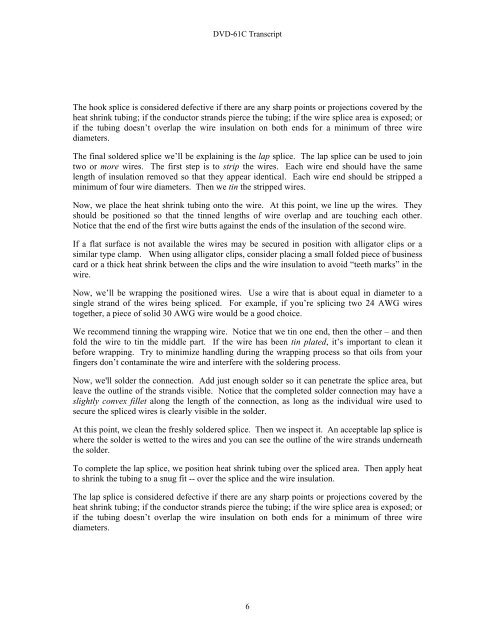DVD-61C Splicing Wires - IPC Training Home Page
DVD-61C Splicing Wires - IPC Training Home Page
DVD-61C Splicing Wires - IPC Training Home Page
Create successful ePaper yourself
Turn your PDF publications into a flip-book with our unique Google optimized e-Paper software.
<strong>DVD</strong>-<strong>61C</strong> TranscriptThe hook splice is considered defective if there are any sharp points or projections covered by theheat shrink tubing; if the conductor strands pierce the tubing; if the wire splice area is exposed; orif the tubing doesn’t overlap the wire insulation on both ends for a minimum of three wirediameters.The final soldered splice we’ll be explaining is the lap splice. The lap splice can be used to jointwo or more wires. The first step is to strip the wires. Each wire end should have the samelength of insulation removed so that they appear identical. Each wire end should be stripped aminimum of four wire diameters. Then we tin the stripped wires.Now, we place the heat shrink tubing onto the wire. At this point, we line up the wires. Theyshould be positioned so that the tinned lengths of wire overlap and are touching each other.Notice that the end of the first wire butts against the ends of the insulation of the second wire.If a flat surface is not available the wires may be secured in position with alligator clips or asimilar type clamp. When using alligator clips, consider placing a small folded piece of businesscard or a thick heat shrink between the clips and the wire insulation to avoid “teeth marks” in thewire.Now, we’ll be wrapping the positioned wires. Use a wire that is about equal in diameter to asingle strand of the wires being spliced. For example, if you’re splicing two 24 AWG wirestogether, a piece of solid 30 AWG wire would be a good choice.We recommend tinning the wrapping wire. Notice that we tin one end, then the other – and thenfold the wire to tin the middle part. If the wire has been tin plated, it’s important to clean itbefore wrapping. Try to minimize handling during the wrapping process so that oils from yourfingers don’t contaminate the wire and interfere with the soldering process.Now, we'll solder the connection. Add just enough solder so it can penetrate the splice area, butleave the outline of the strands visible. Notice that the completed solder connection may have aslightly convex fillet along the length of the connection, as long as the individual wire used tosecure the spliced wires is clearly visible in the solder.At this point, we clean the freshly soldered splice. Then we inspect it. An acceptable lap splice iswhere the solder is wetted to the wires and you can see the outline of the wire strands underneaththe solder.To complete the lap splice, we position heat shrink tubing over the spliced area. Then apply heatto shrink the tubing to a snug fit -- over the splice and the wire insulation.The lap splice is considered defective if there are any sharp points or projections covered by theheat shrink tubing; if the conductor strands pierce the tubing; if the wire splice area is exposed; orif the tubing doesn’t overlap the wire insulation on both ends for a minimum of three wirediameters.6
















